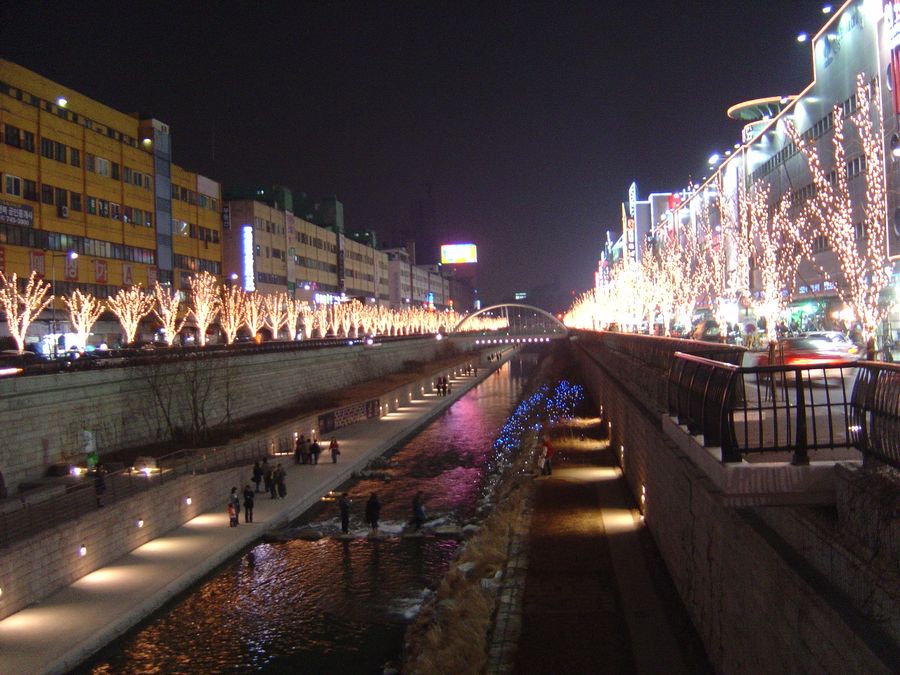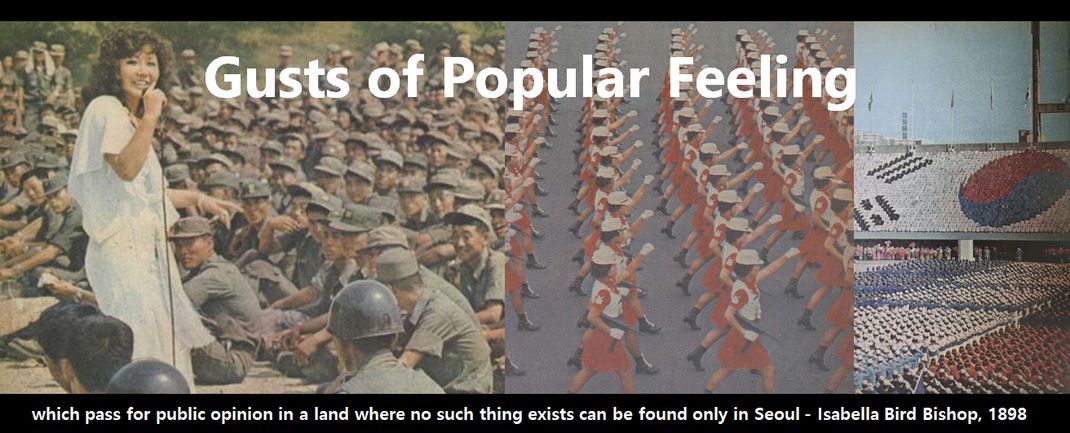
The day before former Hyundai Construction CEO Lee Myung-bak was elected president, the demolition of Dongdaemun Stadium began.

To see a clip with more triumphant music, look here.
The redevelopment of this area was supposedly announced by Oh Se-hoon after he became mayor of Seoul, but the story goes back further. Prior to its destruction, a flea market was to be found in the athletics stadium at Dongdaemun. Prior to that, these vendors were located along and under the old Cheonggye expressway.

The above photo was taken near Dongdaemun Stadium in April, 2003. Here's what it looked like three years later:

As always, the process of the transformation wasn't as pleasant as the final product, as this video shows. The contents of the video are described in this December 1, 2003 Joongang Ilbo article.
Three decades ago, merchants congregated in the Cheonggye area, just east of the city center, to establish what grew to be the largest open-air market in the city, selling all things used, smuggled and shady. But yesterday morning, the Hwanghak-dong Flea Market was no more.
The flea market merchants had piled the street with trash and used tires and set them on fire before dawn yesterday; some of them had been camping out since Saturday night hoping to stop the contractors from moving in.


It took, however, a 20-minute clash between a group of merchants who refused to vacate the sidewalk and hired-gun demolition specialists.

Although violence was anticipated and 4,500 riot policemen were on hand, the battle was an uneven one. The roustabouts hired by the city government numbered about 3,500, facing 250 merchants.

The 250 merchants were no match for the 3,500 workers who surrounded them and quickly chased them away while police looked on.

They and their heavy equipment were delayed for only 20 minutes by vendors swinging steel bars and hurling plastic roadblocks.

By 11:30 a.m., the fight was over; the police have five people in custody, including an official with the national association of street vendors, Hong Kyung-hee, whom they charged with instigating the violence.

A Seoul city official said about 250 merchants who cooperated with the eviction would be able to continue business in the Dongdaemun Stadium area, just south of the old market.Ah, 'roustabouts'. They're usually known as thugs or gangsters. In the video it seems that the only people holding steel bars are the 'roustabouts', but it is just one video. And the police reaction is typical of such situations, where the thugs do the dirty work as the police form a perimeter.
At any rate, it was reported again the next day that the vendors would be moved to Dongdaemun, among other places.
Belongings of 600 merchants out of a total of 1,200 in the Cheonggye area were moved to Seoul’s Dongdaemun Stadium and Nanji Sewage Treatment Plant. The city decided to let 400 merchants who cooperated with the city’s eviction operate their businesses inside the stadium.Not everyone was allowed in the stadium of course, and others were, unexpectedly, not rushing to set up next to the sewage plant. I found the following comment interesting, as it's very similar to criticisms of migrant worker policy in Korea:
Civic groups said the city needs a better policy. “Instead of repeated crackdowns, protests and the resumption of illegal business, the city should establish a registration system to actually issue permits and supervise the street vendors’ operations,” said Kim Eun-hee of the Citizens’ Solidarity for a Walkable and Sustainable City.As for Dongdaemun Stadium, it was opened in 1926 and improved at different points after that.

This Joongang Ilbo article from May, 2004 describes conditions for merchants in the new flea market:
Crammed onto the former athletic field are nearly 900 vendors’ stalls, lined in endless rows on the asphalt field.

He did manage to bring Cheonggyecheon back to life, however, and it proved to be the 'hit product' of 2005 - helped along by spending a little money on PR, of course:
Those who continued trading moved into Dongdaemun Stadium, whose flea market opened Jan. 16. Although traces of the color and old glory endure ― the cornucopia includes fossils of prehistoric animals, brass crafts imported from China, classic vinyl records, antique cameras and old Korean books ― much of the excitement and nostalgia that lured people to Hwanghak-dong in days gone by has vanished. Compounding this, vendors are angry over the city’s perceived failure to keep its promise to provide certain amenities.
The flea-market shopkeepers attributed their plunging sales to several factors such as the cramped conditions in the stadium, as well as the lack of electricity and restrooms. Because electricity cannot be fed into individual stands, stalls must close by sunset.
The city broke its promise to provide services like electricity, water, more restrooms and tents large enough to keep out sun and rain, shopkeepers say ― promises made before the merchants agreed to relocate.
“The sales here are nothing compared to those when we were in Cheonggyecheon, and a shopkeeper running a stall beside mine collapsed from high blood pressure and stress,” said Park Seon-hi, a merchant selling sunglasses. “The city mayor, Lee Myung-bak, killed the flea market.”
In his efforts to publicize his "successful" reopening of the Cheonggyecheon Seoul Mayor Lee Myung-Bak squandered 1 billion won (about 959,000 US dollars) on a variety of public relations program for the stream, which has incurred complaints and anger among the citizens.Worth remembering, however, is that though Lee carried it out, uncovering Cheonggyecheon was not his original idea, as this Far East Economic Review article from January 2004 relates:
Critics argue that all of Mayor Lee's projects including the Cheonggye recovery are actually intended to aid his ambition to become president.
Cynics jeer that Mayor Lee is the most capable mayor of all in the history of Seoul when it comes to publicity.
Yang went on to become a vice mayor under Lee Myung-bak and was later caught taking 100 million won from a construction contractor to relax height restrictions in the Cheonggyecheon area. While it brought benefits of the economic sort to some of the people associated with it (and of course, Hyundai construction took part in the reconstruction), the completion of the stream brought only a brief boost for the vendors in the stadium:For years, Yang Yoon Jae has been leading groups of students along the route of the Cheonggye elevated expressway in downtown Seoul, asking them to imagine how they might reinvigorate the dilapidated neighbourhood. "It's dirty, dusty, noisy, and polluted with bad air. Who wants to live or work along there?" asks Yang, professor of environmental studies at Seoul National University. "We had to do something drastic to change the environment."
Based on sales figures for Sundays, when the market is busiest, the number of visitors declined to 30,000 in the winter of 2004 but recovered to 70,000 last October with the restoration of Cheonggye Stream. However, the number of visitors has fallen again to 30,000 recently.Keep in mind that this article was written on January 26, 2006. On May 10, 2007, the city would announce that they were soliciting designs for the new park, which the Hankyoreh reported on two days later:
Alas, little help may be forthcoming from Seoul City, which plans to convert the surrounding area into a park. The open air stalls in Dongdaemun Stadium are one of the obstacles to the plan, which includes using a nearby baseball field and restoring the Dongdaemun fortress site. But the vendors remain resolute. “If the city closes the flea market in the stadium, we’ll have nowhere else to go. I will not give up on this site, said Mr. Kim.
For these vendors, the demolition moves represent yet another in a long line of broken promises from the Seoul government. This was not their original place of work: they were moved here from the Hwanghak-dong flea market after former Seoul city mayor Lee Myung-bak implemented a restoration project of the Cheonggye stream in 2003. At that time, the vendors believed the former mayor’s pledge to build a world-renowned flea market. However, the pledge changed shortly after incumbent mayor Oh Se-hoon took office in May last year, as one of Oh’s campaign promises was to build a park and a design center nearby Dongdaemun.As that January, 2006 article shows, the plan to demolish Dongdaemun stadium dates back further - in fact much further. Here is a screenshot of a presentation made in September 2004.

It's pretty clear that Dongdaemun stadium is slated to be replaced by green space; another map shows that they planned to rebuilt the city walls through the new park. A great deal of the future planning for downtown Seoul can be found in the presentation, in pdf form here. The 'axis' plans seen above weren't announced to the public until June, 2006. It's hard to be sure, but I imagine these kinds of plans were around for awhile, just waiting for a green light. Is it possible they had decided less than a year earlier that the stadium they were going to move the vendors into was going to be destroyed? If so it was a cynical but successful way to defer a confrontation with the vendors for a few years.
On August 10 the design for the new park was chosen.


Many more images of the project can be found here if you scroll down. One thing that must be said is that they certainly didn't opt for a boring choice. It helps to reinforce the concept of Cheonggyecheon as the precursor that many other redevelopments would cluster around.

A week or so later, on August 22, the Joongang Ilbo reported that
The country’s largest secondhand street market will be relocated from Dongdaemun Stadium to [the grounds of a former middle school in] Sinseol-dong near the Cheonggye Stream, the Seoul city government announced yesterday.The new location can be seen on the map above. It seems to be off the beaten path by a little bit (Dongdaemun Stadium, though inconvienient, was at least next to Dongdaemun market), though the city has promised to help them:
Spending 3 billion won ($3.1 million), the city vowed to transform the new marketplace into a tourist attraction for domestic and foreign visitors by March next year.It's a step up from the treatment the vendors received when they were first moved to the stadium. Whether the city will follow through on this promise is a question for another day. What's interesting is the way the history of the past few years is glossed over in the following paragraph of the article.
The market, selling secondhand goods and antiques, was originally located in Hwanghak-dong, Jung District, next to the Cheonggye Stream, which was then covered by a road. In January 2004, the market’s 900 street vendors were moved into a soccer stadium in Dongdaemun after Lee Myung-bak, then mayor of Seoul, decided to restore the stream. Last year, Seoul Mayor Oh Se-hoon announced the demolition of Dongdaemun Stadium to transform the area into a fashion street with a park, enraging the street vendors who were faced with eviction again.Other than the last sentence, it almost makes it seem painless and inevitable, when you look back at it in this way. As for the present, I imagine the process I described above will play itself out with ever increasing frequency over the next five years.




1 comment:
The new project looks like an improvement. Too bad it takes violence to get these things going.
Post a Comment